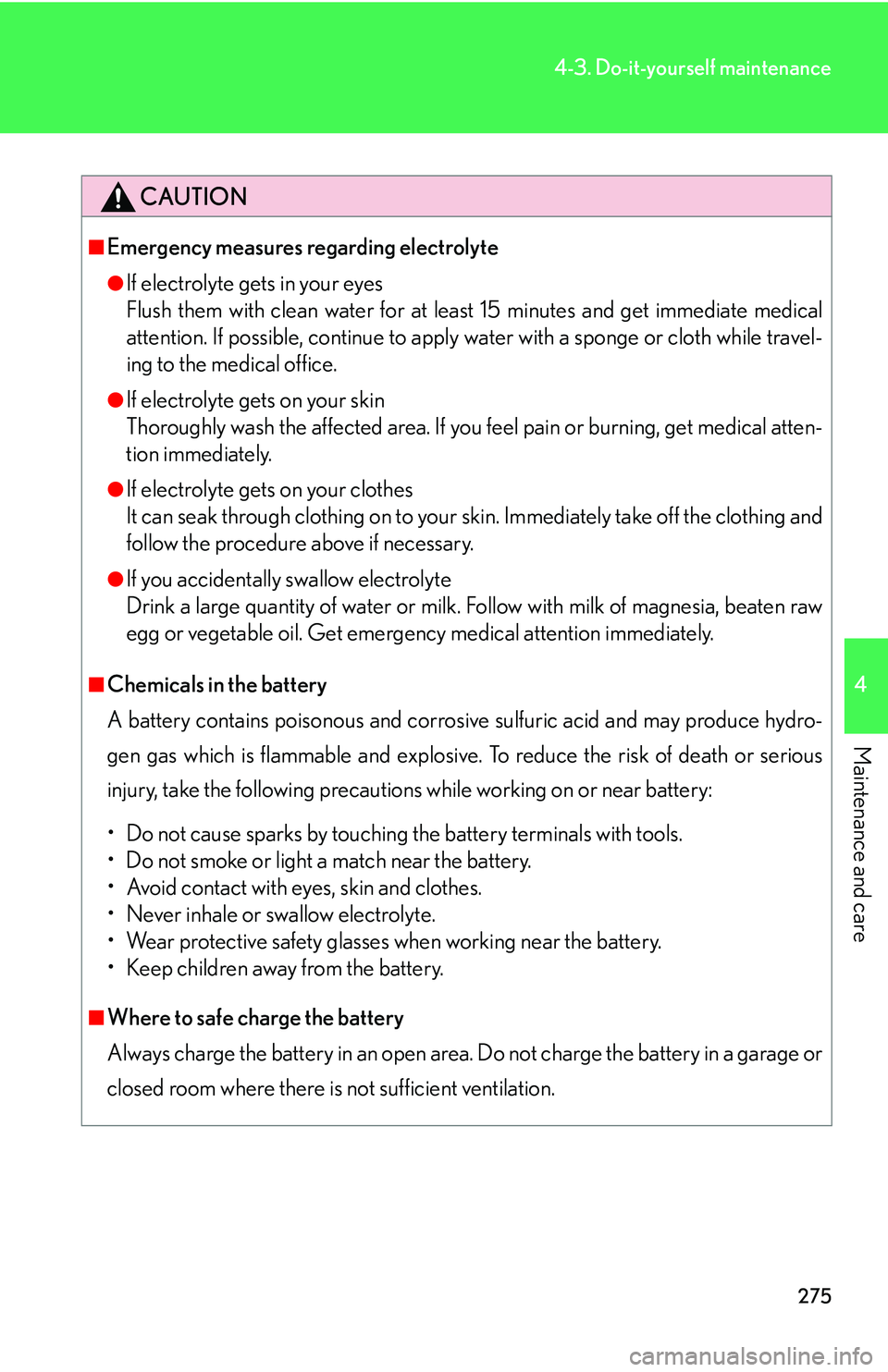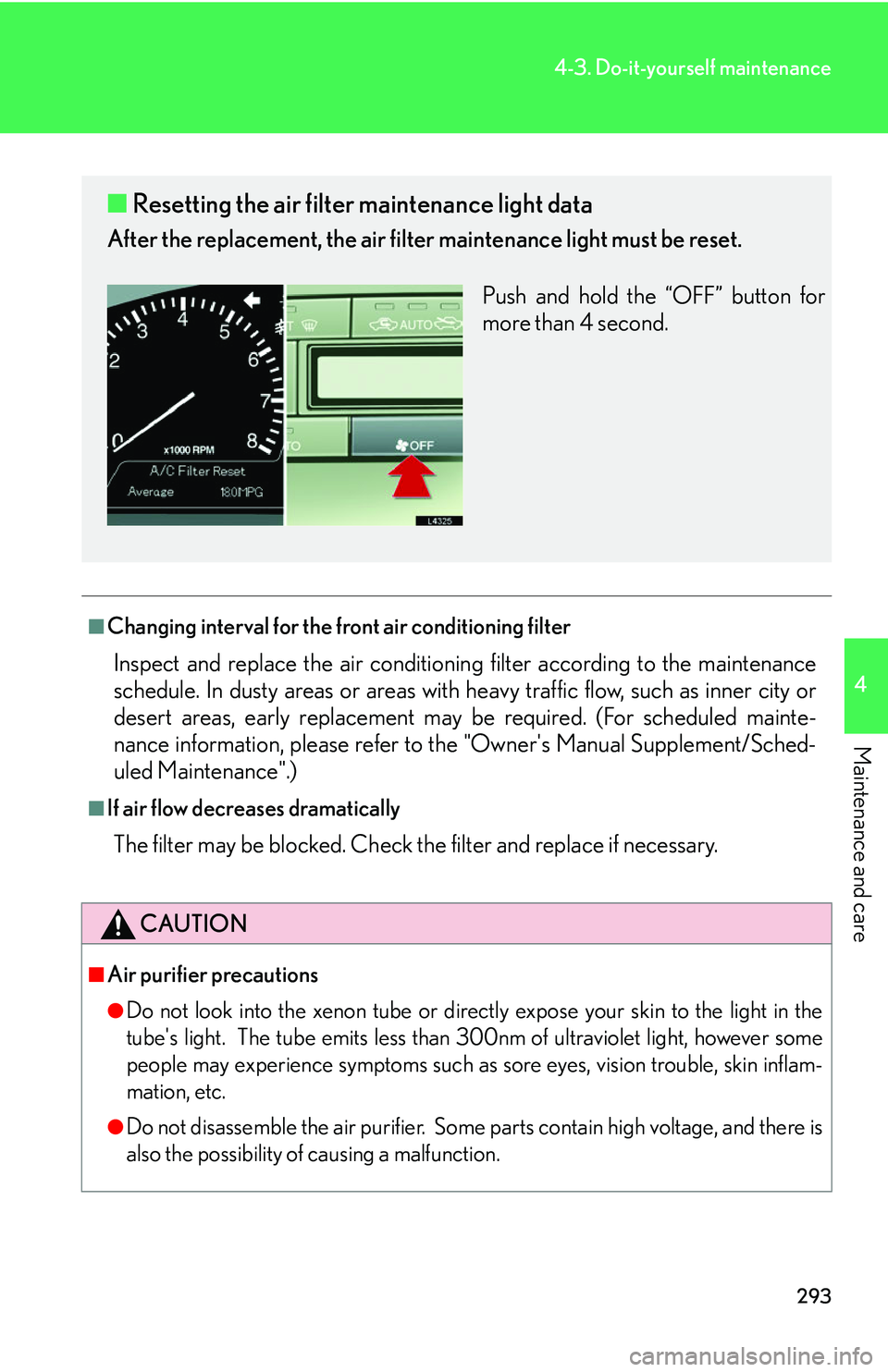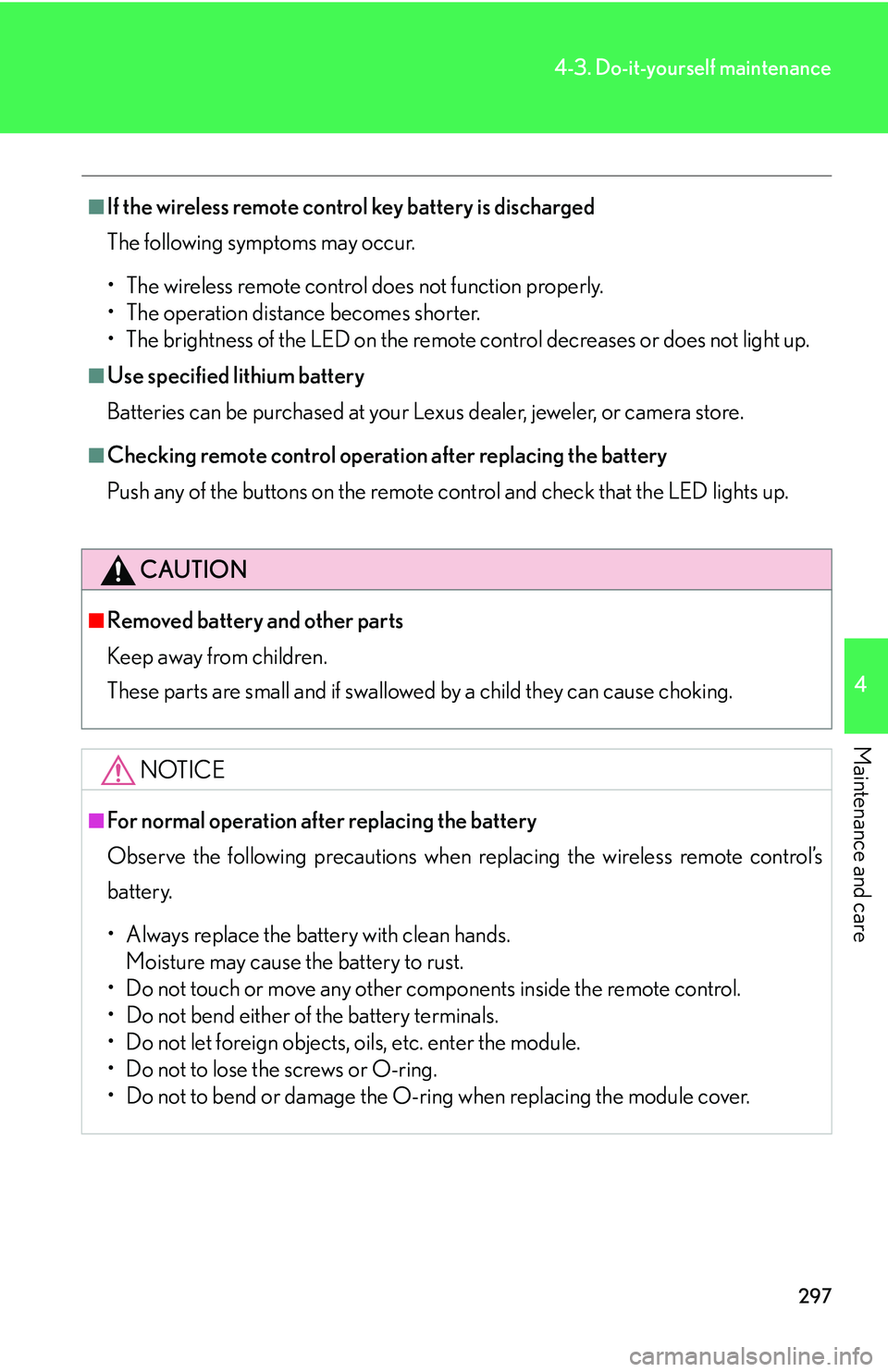Page 273 of 419
257
4-3. Do-it-yourself maintenance
4
Maintenance and care
Do-it-yourself maintenancePa r t s a n d t o o l s
Headlight aim
( P.311)
• Phillips-head screwdriver
Power steering fluid
level
(P. 2 7 2 )
• Automatic transmission fluid DEXRON ll or
lll
• Rag or paper towel
• Funnel (used only for adding power steering fluid)
Radiator and
condenser
(P. 2 6 9 )
Tire inflation pressure
(P. 2 8 3 )
• Tire pressure gauge
• Compressed air source
Wa s h e r f l u i d
(P. 2 7 7 )
• Washer fluid containing antifreeze
(for winter use)
• Funnel (used only for adding washer fluid)
Page 276 of 419
260
4-3. Do-it-yourself maintenance
Hood
CAUTION
■Pre-driving check
Check that the hood is fully closed and locked.
If the hood is not locked properly it may open while the vehicle is in motion and
ca
use an accident, which may result in death or serious injury.
Lift the hood to inspect engine components and fluid levels.
Pull the hood release lever.
The hood will pop up slightly.
Lift the hood catch and lift the hood.
Page 281 of 419
265
4-3. Do-it-yourself maintenance
4
Maintenance and care
■ How to read oil container labels
The ILSAC (International Lubricant Standardization and approval Commit -
tee) Certification mark is are added to some oil
containers to help you select
the oil you should use.
ILSAC Certification Mark
■Resetting the engine oil maintenance information data (U.S.A. only)
After replacing the engine oil, be sure to
reset the maintenance data. Otherwise,
the engine oil maintenance information may not function correctly. ( P.334 )
Push the "TRIP" button to change t
he trip meter display to blank.
Turn the ignition switch off.
Turn the ignition switch to "ON" while pushing
the trip meter "RESET"
button.
Keep pushing the trip meter "RESET " button for lon
ger than 5 seconds.
"Mileage Reset" appears on
the display, the master warning light comes
on, and a warning tone sounds.
Page 287 of 419
271
4-3. Do-it-yourself maintenance
4
Maintenance and care
CAUTION
■When filling the reservoir
Be careful because brake fluid can harm your hands and eyes and damage painted
sur
faces.
If fluid gets in your eyes, flush your eyes with clean water immediately.
If you still experience discom for
t, seek medical attention.
NOTICE
■If the fluid level is low or high
It is normal for the brake fluid level to go down slightly as the brake pads wear or
whe
n the fluid level in the accumulator is high.
If the reservoir needs frequent refilling, it may indicate a serious mechanical prob -
lem. Have the system checked by your Lexus dealer.
Page 288 of 419

272
4-3. Do-it-yourself maintenance
Power steering fluid
■Fluid level
The fluid level should be within the
appropriate range.
Full line when cold
Add fluid if at or below line
when cold.
Full line when hot
Add fluid if at or below line
when hot.
Hot : If the vehicle has been driven around 50 mph (80 km/h) for 20 min -
utes (slightly longer in frigid te mper
atures), the fluid is hot (140F -
175
F or 60C - 80C).
Cold : If the engine has not been run for about
five hours, the fluid is cold.
(about room temperature, 50
F - 85F or 10C - 30C).
■ Checking the fluid level
Make sure to check the fluid type and prepare the necessary items before
checking.
Clean all dirt off the reservoir.
Remove the reservoir cap by tu rning it counter
clockwise and
wipe the dipstick clean.
Reinstall the reservoir cap.
Remove the reservoir cap again and look at the fluid le
vel.
1
2
3
4
Fluid typeAutomatic transmission fluid DEXRON II or III
ItemsRag or paper towel and funnel (only for adding fluid)
Page 291 of 419

275
4-3. Do-it-yourself maintenance
4
Maintenance and care
CAUTION
■Emergency measures regarding electrolyte
●If electrolyte gets in your eyes
Flush them with clean water for at leas t 15 minutes
and get immediate medical
attention. If possible, continue to apply water with a sponge or cloth while travel -
ing to the medical office.
●If electrolyte gets on your skin
Thoroughly wash the affected area. If you feel p
ain or burning, get medical atten-
tion immediately.
●If electrolyte gets on your clothes
It can seak through clothing on to your skin. Immediat
ely take off the clothing and
follow the procedure above if necessary.
●If you accidentally swallow electrolyte
Drink a large quantity of water or milk. Fo l
low with milk of magnesia, beaten raw
egg or vegetable oil. Get emergency medical attention immediately.
■Chemicals in the battery
A battery contains poisonous and corrosive sulfuric acid and may produce hydro -
gen gas which is flammable and explosive. To reduce the risk of death or serious
injur
y, take the following precautions while working on or near battery:
• Do not cause sparks by touching the battery terminals with tools.
• Do not smoke or light a match near the battery.
• Avoid contact with eyes, skin and clothes.
• Never inhale or swallow electrolyte.
• Wear protective safety glasses when working near the battery.
• Keep children away from the battery.
■Where to safe charge the battery
Always charge the battery in an open area. Do not charge the battery in a garage or
cl
osed room where there is not sufficient ventilation.
Page 309 of 419

293
4-3. Do-it-yourself maintenance
4
Maintenance and care
■Changing interval for the front air conditioning filter
Inspect and replace the air conditioning filter according to the maintenance
schedule. In dusty areas or areas with heavy traffic flow, such as inner city or
desert areas, early replacement may be required. (For scheduled mainte -
nance information, please refer to the "Owner's Manual Supplement/Sched-
uled Maintenance".)
■If air flow decreases dramatically
The filter may be blocked. Check the filter and replace if necessary.
CAUTION
■Air purifier precautions
●Do not look into the xenon tube or directly expose your skin to the light in the
tube's light. The tube emits less than 300nm of ultraviolet light, however some
people may experience symptoms such as sore eyes, vision trouble, skin inflam-
mation, etc.
●Do not disassemble the air purifier. Some parts contain high voltage, and there is
also the possibility of causing a malfunction.
■ Resetting the air filter maintenance light data
After the replacement, the air filter maintenance light must be reset.
Push and hold the “OFF” button for
mor
e than 4 second.
Page 313 of 419

297
4-3. Do-it-yourself maintenance
4
Maintenance and care
■If the wireless remote control key battery is discharged
The following symptoms may occur.
• The wireless remote control does not function properly.
• The operation distance becomes shorter.
• The brightness of the LED on the remote c
ontrol decreases or does not light up.
■Use specified lithium battery
Batteries can be purchased at your Lexus dealer, jeweler, or camera store.
■Checking remote control operation after replacing the battery
Push any of the buttons on the remote control and check that the LED lights up.
CAUTION
■Removed battery and other parts
Keep away from children.
These parts are small and if swallowed by a child they can cause choking.
NOTICE
■For normal operation after replacing the battery
Observe the following precautions when replacing the wireless remote control’s
ba
ttery.
• Always replace the battery with clean hands.
Moisture may cause the battery to rust.
• Do not touch or move any other comp o
nents inside the remote control.
• Do not bend either of the battery terminals.
• Do not let foreign objects, oils, etc. enter the module.
• Do not to lose the screws or O-ring.
• Do not to bend or damage the O-ring when replacing the module cover.